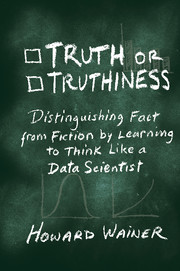Book contents
- Frontmatter
- Dedication
- Contents
- Preface and Acknowledgments
- Introduction
- Section I Thinking Like a Data Scientist
- Section II Communicating Like a Data Scientist
- 8 On the Crucial Role of Empathy in the Design of Communications: Genetic Testing as an Example
- 9 Improving Data Displays: Th e Media's and Ours
- 10 Inside Out Plots
- 11 A Century and a Half of Moral Statistics: Plotting Evidence to Aff ect Social Policy
- Section III Applying the Tools of Data Science to Education
- Section IV Conclusion: Don't Try Th is at Home
- Bibliography
- Sources
- Index
8 - On the Crucial Role of Empathy in the Design of Communications: Genetic Testing as an Example
from Section II - Communicating Like a Data Scientist
Published online by Cambridge University Press: 05 December 2015
- Frontmatter
- Dedication
- Contents
- Preface and Acknowledgments
- Introduction
- Section I Thinking Like a Data Scientist
- Section II Communicating Like a Data Scientist
- 8 On the Crucial Role of Empathy in the Design of Communications: Genetic Testing as an Example
- 9 Improving Data Displays: Th e Media's and Ours
- 10 Inside Out Plots
- 11 A Century and a Half of Moral Statistics: Plotting Evidence to Aff ect Social Policy
- Section III Applying the Tools of Data Science to Education
- Section IV Conclusion: Don't Try Th is at Home
- Bibliography
- Sources
- Index
Summary
Good information design is clear thinking made visible, while bad design is stupidity in action.
Edward Tufte 2000An effective memo should have, at most, one point.
Paul Holland 1980The effectiveness of any sort of communication depends strongly on the extent to which the person preparing the communication is able to empathize with its recipients. To maximize effectiveness it is absolutely crucial to determine what information the receiver needs to hear and not let that be overwhelmed by other things that you may want to tell her.
We get a sense of how hard it is to do this when we see how celebrated are those rare communications that do it well. More than a dozen years ago my son received a letter from Princeton University in response to his application. That letter, reproduced in the following text, exemplifies the empathetic attitude I recommend. Fred Hargadon, then Princeton's dean of admission, recognized that the recipient is principally interested in just one thing, and he designed his famous letter to focus on just that (see Figure 8.1).
Only 8 percent of Princeton's more than twenty thousand applicants received such a letter, but it isn't hard to imagine the character of a parallel version (imagined in Figure 8.2) that might have been sent to the remaining 92 percent.
Of course, Princeton did not send such a letter. I was told that the parallel version I ginned up was never in the cards. When I asked about the character of the actual “No!” letter, Dean LeMenager told me “You can say ‘Yes’ quickly; ‘No’ takes a lot longer.”
Letters announcing the outcome of an application to a selective university or offering a job are but two of the many important situations in which information is conveyed to a candidate. Crafting such messages is rarely done as thoughtfully as Princeton's remarkable letter. But these circumstances, as important as they are, pale in comparison with other kinds of communications. One of these arose on May 14, 2013, when Angelina Jolie wrote an OpEd essay in the New York Times telling of her decision to have a double mastectomy.
- Type
- Chapter
- Information
- Truth or TruthinessDistinguishing Fact from Fiction by Learning to Think Like a Data Scientist, pp. 82 - 90Publisher: Cambridge University PressPrint publication year: 2015



